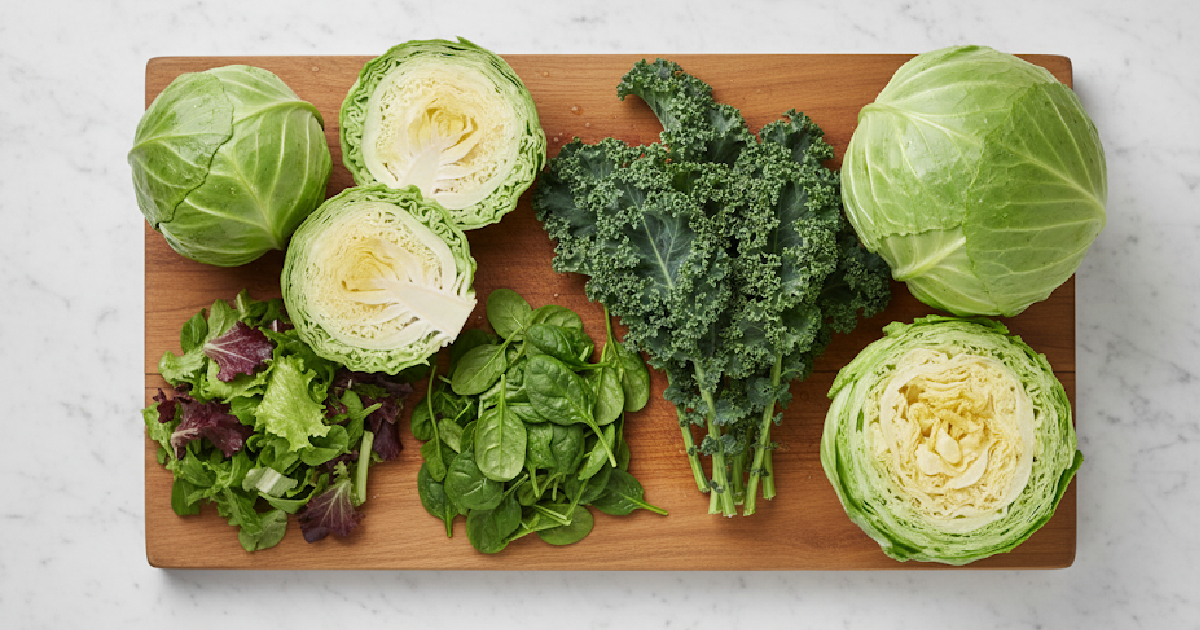If you’ve ever stood in the produce aisle wondering whether that leafy head in front of you is lettuce or cabbage, you’re not alone. Many greens share a similar look but are surprisingly different when it comes to taste, nutrition, and how they’re used in cooking. Understanding lettuce vs other vegetables such as cabbage, spinach, kale, and iceberg helps clear up the confusion. While some are crisp and refreshing, others are hearty and nutrient-dense, making them better suited for certain dishes. In this guide, we’ll break down the differences so you know exactly when to choose lettuce, and when another green might be the better pick.
Cabbage vs Lettuce: The Key Differences
Cabbage vs lettuce is one of the most common comparisons. While both form leafy heads, they differ in several important ways:
- Texture: Cabbage leaves are thick, firm, and slightly rubbery, while lettuce leaves are tender and crisp.
- Taste: Cabbage has a stronger, sometimes peppery flavor, while lettuce is mild and watery.
- Cooking vs Raw: Cabbage is commonly used in cooked dishes like soups, stir-fries, and kimchi. Lettuce is almost always eaten raw in salads and wraps.
- Nutrition: Cabbage is higher in vitamin C and fiber, while lettuce is lighter, offering hydration and fewer calories.
So, is cabbage and lettuce same? Definitely not. They might look alike at first glance, but they belong to different plant families and serve very different roles in the kitchen.
If you want to understand why lettuce has softer leaves compared to cabbage’s dense layers, learning about the Lettuce Plant offers helpful insight into its growth pattern.
Iceberg Lettuce vs Cabbage: How to Tell Them Apart
Among all lettuces, iceberg is most often confused with cabbage because of its round head and pale-green color. But look closer, and you’ll spot clear differences:
- Iceberg Lettuce: Light green, airy, and crisp, with a high water content.
- Cabbage: Dense, compact, and much heavier, with tougher leaves.
While both add crunch, iceberg is refreshing and best for salads, while cabbage is hearty and holds up well in cooking.
Spinach vs Lettuce: Which Is Better for Salads?
Spinach vs lettuce is another big debate. Both are popular greens, but they’re not interchangeable.
- Taste: Spinach has a slightly earthy, sometimes bitter flavor, while lettuce is neutral and refreshing.
- Texture: Spinach leaves are denser and chewier, while lettuce is lighter and crunchier.
- Nutrition: Spinach is loaded with iron, calcium, and vitamin C, making it a nutritional powerhouse. Lettuce, though less nutrient-dense, offers hydration and is low in calories.
Both have their place. If you’re after a nutrition boost, spinach wins. For a light, crisp salad, lettuce is the better choice. For a deeper dive into nutrients, checking out Lettuce Nutrition highlights why even this “lighter” green is worth eating.
Kale vs Lettuce: Nutritional and Taste Comparison
Kale vs lettuce often comes up because kale has been branded a “superfood.” Here’s how the two compare:
- Texture: Kale leaves are firm, curly, and fibrous. Lettuce is soft and delicate.
- Flavor: Kale is bold and slightly bitter; lettuce is mild.
- Nutrition: Kale contains more antioxidants and vitamins A, C, and K compared to lettuce.
While kale is excellent for smoothies and cooked dishes, lettuce is easier to enjoy raw. If you’re thinking of adding both to your garden, it helps to first Name things that gardeners need so you’re prepared to grow a variety of leafy greens successfully.
Lettuce vs Iceberg: What’s the Real Difference?
Many wonder about lettuce vs iceberg, but the truth is simple: iceberg is just one type of lettuce. It belongs to the crisphead group, known for its tightly packed, crunchy leaves.
So what’s the difference?
- Iceberg Lettuce: Refreshing crunch, mild taste, and great for texture.
- Other Lettuces (like romaine, butter, or leaf lettuce): More flavor, darker colors, and higher nutrient content.
That’s why green lettuce vs iceberg lettuce is really about preference. Iceberg wins on crunch, while green leaf or romaine win on nutrients and flavor.
For those inspired to grow at home, even iceberg can be cultivated with patience. Guides on Lettuce Cultivation can help you get started with the right soil and season.
Green Lettuce vs Iceberg Lettuce: Which Should You Choose?
Choosing between green lettuce vs iceberg lettuce depends on your goal:
- For Crunch: Iceberg lettuce is unbeatable.
- For Flavor and Nutrition: Green lettuce varieties provide more vitamins and a deeper taste.
- For Versatility: Green lettuce can be used in a wider range of dishes, while iceberg is mostly a salad and sandwich favorite.
Much like choosing between vegetables, gardening is also about variety. If you enjoy exploring plant diversity, you’ll love learning about unique blooms like the Buraansh Flower, or even discovering Which Flower Bloom in the Day and Close at Night to see how plants have their own natural rhythms.
Quick Comparison Table: Lettuce vs Other Vegetables
| Vegetable | Texture | Flavor | Nutrition Highlights | Best Use |
| Lettuce | Soft, crisp | Mild, watery | Hydrating, low-calorie, vitamin A | Salads, wraps, sandwiches |
| Cabbage | Firm, dense | Strong, peppery | Vitamin C, fiber, folate | Soups, stir-fries, fermentation |
| Iceberg Lettuce | Crunchy, airy | Neutral, refreshing | Hydration, small vitamin content | Salads, burgers, tacos |
| Spinach | Chewy, dense | Earthy, slightly bitter | Iron, calcium, vitamin C | Smoothies, salads, sautés |
| Kale | Firm, fibrous | Bold, slightly bitter | High antioxidants, vitamins A, C, K | Smoothies, chips, stir-fries |
Conclusion
So, is lettuce and cabbage same? Not at all. Cabbage is dense and hearty, built for cooking, while lettuce is light and crisp, perfect for raw dishes. Spinach and kale bring more nutrients but stronger flavors, while iceberg is simply one type of lettuce loved for its crunch. Each green has its own strengths, and knowing the difference helps you make smarter choices for cooking, health, and even gardening.


